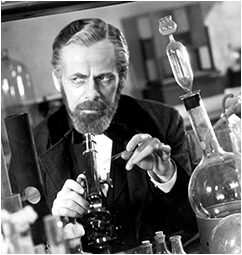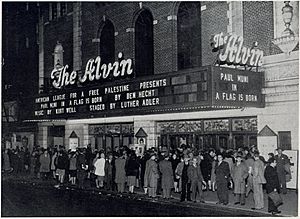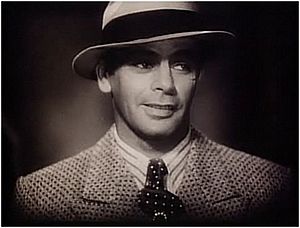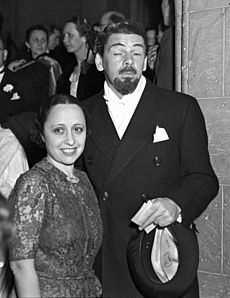Paul Muni facts for kids
Quick facts for kids
Paul Muni
|
|
|---|---|
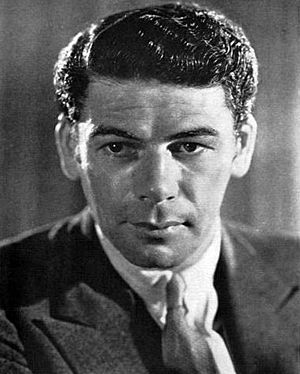
Paul Muni in 1936
|
|
| Born |
Frederich Meshilem Meier Weisenfreund
September 22, 1895 |
| Died | August 25, 1967 (aged 71) Montecito, California, U.S.
|
| Resting place | Hollywood Forever Cemetery |
| Other names | Muni Weisenfreund |
| Occupation | Actor |
| Years active | 1908–1962 |
| Spouse(s) |
Bella Finkel
(m. 1921) |
Paul Muni (born Frederich Meshilem Meier Weisenfreund; September 22, 1895 – August 25, 1967) was a famous American stage and film actor. He grew up in Chicago and became known for playing strong and important characters.
Paul Muni was nominated for an Academy Award five times and won once. He started his acting journey in the Yiddish theater. In the 1930s, he was one of the most respected actors at Warner Bros. studio. He was even allowed to choose his own movie roles, which was very rare!
He was great at acting because he prepared a lot for his roles. He would study the real people he was playing very carefully. He was also a master at using makeup to change his appearance. He learned this skill from his parents, who were also actors. When he was just 12 years old, he played an 80-year-old man on stage! In one of his films, Seven Faces, he played seven different characters.
Paul Muni made 22 films. He won the Academy Award for Best Actor for his role in the 1936 movie The Story of Louis Pasteur. He also acted in many Broadway plays. He won a Tony Award for Best Actor in a Play for his role in the 1955 play Inherit the Wind.
Contents
Early Life and Acting Start
Paul Muni was born in 1895 as Frederich Meier Weisenfreund. His family was Jewish and lived in Lemberg, which is now Lviv, Ukraine. His first language was Yiddish. When he was seven, his family moved to the United States in 1902 and settled in Chicago.
As a boy, people called him "Moony." He began acting in the Yiddish theater in Chicago with his parents, who were both actors. As a teenager, he became very good at using makeup. This helped him play characters who were much older than him. A film historian named Robert Osborne said that Muni's makeup skills were so creative that he could completely change how he looked for most of his roles. People even called him "the new Lon Chaney" because of this. His very first stage role, at age 12, was playing an 80-year-old man.
A famous theater director, Maurice Schwartz, quickly noticed his talent. He signed Muni to work with his Yiddish Art Theater. In 1921, Paul Muni married Bella Finkel, who was also an actress in the Yiddish theater. They stayed married until his death in 1967.
Paul Muni started acting on Broadway in 1926. His first role was an elderly Jewish man in a play called We Americans. This was the first time he had ever acted in English.
Becoming a Hollywood Star
In 1929, Paul Muni signed a contract with Fox. His name was made simpler and more American, becoming Paul Muni, from his childhood nickname "Moony." His acting skills were quickly noticed. He received an Oscar nomination for his first film, The Valiant (1929). His second film, Seven Faces (also 1929), did not do well. Because he wasn't happy with the roles he was offered, he went back to Broadway. There, he starred in a very successful play called Counsellor at Law.
Paul Muni soon returned to Hollywood. He starred in powerful films like the original Scarface and I Am a Fugitive from a Chain Gang (both 1932). For I Am a Fugitive from a Chain Gang, he was nominated for an Oscar for Best Actor. His great performance in this film impressed Warner Bros. so much that they signed him to a long contract. They promoted him as "the screen's greatest actor."
In 1935, Muni convinced Warner Bros. to take a chance on making a historical movie about a real person, The Story of Louis Pasteur. This was the first of many biographical roles for Muni. He played the brilliant scientist Louis Pasteur, who had to fight against people who didn't believe his medical ideas. The movie was a big success. Muni won an Oscar for his amazing performance.
He went on to play other important historical figures. He played Émile Zola, a man who stood up for what was right, in The Life of Emile Zola (1937). He was nominated for an Oscar for this role, and the film won Best Picture. He also played the main role in Juarez (1939).
In 1937, Muni played a Chinese farmer in the movie The Good Earth, based on Pearl S. Buck's novel. His co-star, Luise Rainer, won an Academy Award. The film showed a time of big change in China. When producer Irving Thalberg offered him the role, Muni joked, "I'm about as Chinese as [President] Herbert Hoover."
Paul Muni was not always happy with Hollywood life. He chose not to renew his contract and only acted in movies sometimes after that. He played Frédéric Chopin's teacher in A Song to Remember (1945). In 1946, he starred in a rare comedy, Angel on My Shoulder. In this movie, he played a tough guy whose soul ends up in the body of a judge, turning him into a good person.
Later Career and Stage Work
After his main Hollywood career, Paul Muni focused most of his energy on stage plays and occasional television roles. In 1946, he appeared on Broadway in A Flag is Born, a play written to support the creation of a Jewish state in Israel. This play also starred a young Marlon Brando. Years later, Brando said that Muni was the greatest actor he had ever seen. In 1949, Muni played Willy Loman in the first British production of Death of a Salesman in London.
In 1952, Muni traveled to Italy to star in Imbarco a mezzanotte. He did this partly to show support for friends who were facing difficulties and living in exile.
A few years later, in 1955 and 1956, Muni had his biggest stage success in the United States. He played the determined lawyer, Henry Drummond, in Inherit the Wind. This role was based on the real lawyer Clarence Darrow. Muni won a Tony Award for Best Performance by a Leading Actor in a Play for this role. In August 1955, Muni had to leave the play because of a serious eye problem that affected his eyesight. His eye was removed in an operation. However, he returned to his starring role in Inherit the Wind in December 1955.
His last movie role was as an older doctor in The Last Angry Man (1959), for which he was again nominated for an Oscar. After this, Muni mostly stopped acting due to his failing eyesight and other health issues. His final appearance was on television in a show called Saints and Sinners in 1962.
Acting Style and Legacy
Paul Muni was known for how much he prepared for his roles, especially when playing real people. For The Story of Louis Pasteur, Muni said he read almost everything he could find about Pasteur and his time. He did the same for his role as Henry Drummond in Inherit the Wind, studying photographs and talking to people who knew the real Clarence Darrow. The New York Times wrote that for Paul Muni, "acting was not just a career, but an obsession." They noted that he put all his effort into each role.
Since Muni grew up in an acting family, he learned his craft very well. On stage, his voice could reach the very back of any theater. His acting style had the "warmth of the Yiddish stage" where he started at age 12. Also, his makeup skills were like "a work of art." He combined his control of voice and movements to create a unique acting style.
Film historian David Shipman called Muni "an actor of great integrity" who prepared carefully for his roles. Muni was known for being a bit unusual but very talented. He didn't like anyone wearing red around him, and he often played his violin between takes. As he got older and his eyesight failed, he relied more and more on his wife, Bella. Muni was very firm about his artistic choices. He once turned down a huge movie contract because he didn't like the roles the studio offered.
Personal Life
In his private life, Paul Muni was very shy. He felt uncomfortable when people recognized him while he was out shopping or eating. He loved to read and go for walks with his wife in quiet parts of Central Park. He always arrived at the theater early to get ready for his performance. After he retired from acting, he lived in California in a simple home where he and his wife enjoyed their privacy. He died of a heart problem in Montecito, California, in 1967, at age 71. He is buried in the Hollywood Forever Cemetery in Hollywood.
Awards and Recognitions
Paul Muni received four official Academy Award nominations for Best Actor. He won for The Story of Louis Pasteur (1936). He was also nominated for I Am a Fugitive from a Chain Gang (1932), The Life of Emile Zola (1937), and The Last Angry Man (1959).
Other honors include:
- New York Film Critics Circle Award for The Life of Emile Zola
- Tony Award for Best Actor in Inherit the Wind
- A star on the Hollywood Walk of Fame at 6435 Hollywood Blvd.
- A film musical about his life, Actor: The Paul Muni Story (1978), starred Herschel Bernardi.
- A biography titled Actor: The Life and Times of Paul Muni (1974) was written by Jerome Lawrence.
Filmography
| Year | Title | Role | Notes |
|---|---|---|---|
| 1929 | The Valiant | James Dyke | Nominated — Academy Award for Best Actor |
| 1929 | Seven Faces | Papa Chibou / Diablero / Willie Smith / Franz Schubert / Don Juan / Joe Gans / Napoleon |
Lost film |
| 1932 | Scarface | Antonio "Tony" Camonte | |
| 1932 | I Am a Fugitive from a Chain Gang | James Allen | Nominated — Academy Award for Best Actor |
| 1933 | The World Changes | Orin Nordholm Jr. | |
| 1934 | Hi, Nellie! | Brad Bradshaw | |
| 1935 | Bordertown | Johnny Ramirez | |
| 1935 | Black Fury | Joe Radek | |
| 1935 | Dr. Socrates | Dr. Lee Cardwell, nicknamed "Dr. Socrates" | |
| 1936 | The Story of Louis Pasteur | Louis Pasteur | Academy Award for Best Actor Volpi Cup for Best Actor |
| 1937 | The Good Earth | Wang Lung | Released in sepia tone |
| 1937 | The Woman I Love | Lt. Claude Maury | |
| 1937 | The Life of Emile Zola | Émile Zola | New York Film Critics Circle Award for Best Actor Nominated — Academy Award for Best Actor |
| 1939 | Juarez | Benito Juárez | |
| 1939 | We Are Not Alone | Dr. David Newcome | |
| 1941 | Hudson's Bay | Pierre-Esprit Radisson | |
| 1942 | Commandos Strike at Dawn | Erik Toresen | |
| 1943 | Stage Door Canteen | Himself | |
| 1945 | A Song to Remember | Prof. Joseph Elsner | Filmed in Technicolor |
| 1945 | Counter-Attack | Alexei Kulkov | |
| 1946 | Angel on My Shoulder | Eddie Kagle / Judge Fredrick Parker | |
| 1952 | Imbarco a mezzanotte | The Stranger with a Gun | called Stranger on the Prowl in the U.S. |
| 1959 | The Last Angry Man | Dr. Samuel "Sam" Abelman | Mar del Plata Film Festival Award for Best Actor Nominated — Academy Award for Best Actor Nominated — New York Film Critics Circle Award for Best Actor |
Radio Appearances
| Year | Program | Episode/Source |
|---|---|---|
| 1936 | Lux Radio Theatre | The Story of Louis Pasteur |
- Lux Radio Theater. "The Life of Emile Zola". May 8, 1939
- Calvalcade of America. "Edwin Booth". March 31, 1941
- The Free Company. "The Miracle Of The Danube". April 27, 1941
- Calvalcade of America. "Bolivar, The Liberator". October 6, 1941
- Calvalcade of America. "Eagle's Nest". December 28, 1942
- Radio Hall of Fame. "No Uncommon Clay". April 30, 1944
- Suspense Theater. "The Search For Henri Leferve". July 6, 1944
- Arch Ololer's Plays. "This Living Book". October 11, 1945
- Academy Award Theater. April 13, 1946
- Eternal Light. "And It Came To Pass". December 7, 1947
- Studio One. "Amazing Dr. Clitterhouse". January 20,1948
- Calvalcade of America. "Alerting of Dr. Pomerantz". February 16, 1948
- Calvalcade of America. "Garden Key". November 8, 1948
- Biography in Sound. "Clarence Darrow". September 13, 1956
See also
 In Spanish: Paul Muni para niños
In Spanish: Paul Muni para niños
- List of actors with Academy Award nominations
- List of German-speaking Academy Award winners and nominees


